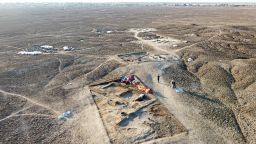Editor’s Note: Sign up for CNN’s Wonder Theory science newsletter. Explore the universe with news on fascinating discoveries, scientific advancements and more.
Archaeologists working in Saudi Arabia and Jordan say they have discovered the oldest known architectural plans.
The “extremely precise depictions” engraved on stone slabs detail huge structures used to funnel wild animals such as gazelles into enclosures where whole herds could be slaughtered, according to a new study published Wednesday in the scientific journal PLOS One.
The Stone Age hunting traps date back about 9,000 years and are known as kites because of the shape they form. The ancient traps were first discovered in the deserts of the Middle East in the 1920s by aircraft pilots who spotted the striking shapes in the landscape.
Long converging walls, from hundreds of meters to 5 kilometers (3.1 miles) long, drive animals toward a large corral that is surrounded by a number of pits up to 4 meters (13.1 feet) deep. Some of the desert kites were the largest structures built in human history at the time of their construction.
“These structures are so large. When you’re on the ground in the field it’s hard to understand how they are built, what the layout and shape is,” said archaeologist Wael Abu Azizeh, head of the Jerusalem/Palestinian territories office at the French Institute of the Near East and a co-lead author of the study.

More than 6,000 kite structures have been found across the Middle East and central Asia, and they are most numerous in what’s now northern Saudi Arabia, southern Syria and eastern Jordan. However, the archaeological phenomenon has been little studied.
The accurate drawings of the massive kites suggested that the people who built and used the traps had advanced and sophisticated knowledge of perceived space and were able to process complex spatial information.
“In terms of cognitive development this is quite, quite amazing,” Abu Azizeh said.
Engravings made to scale

In the latest research, archaeologists reported the discovery of two engraved slabs found in 2015 in Jordan and Saudi Arabia.
Abu Azizeh was part of the team that discovered one of the artifacts at a former settlement in the Jibal al-Khashabiyeh area in Jordan that is home to eight hunting kites.
He said he knew “within seconds” that the markings made on the 80-centimeter-long (2.6-foot-long) stone, thought to be 7,000 years old, represented a nearby kite.
“I had in mind the idea of the kites nearby and it came very suddenly, very quickly. And immediately to me that was a drawing of a kite,” Abu Azizeh said.
His colleagues in Saudi Arabia unearthed a larger engraved stone in the region of Jebel az-Zilliyat that was almost 4 meters (13 feet) long. The slab depicted two different kites that were only 120 meters (394 feet) apart. The engraving is thought to have been made 8,000 years ago.
The shape, layout and proportions of the engravings were consistent with actual remains of the kites, the study found. The depictions were also in keeping with cardinal directions — north, east, south and west. The engraving found in Saudi Arabia was created at a scale of approximately 1:175, meaning that the actual kites were 175 times larger than the engraving. The kite in Jordan was 425 times larger than the schematic marked on the other found slab.
“The engravings are surprisingly realistic and accurate, and are moreover to scale,” the study said.
The only exception was the oversize representation of the deep pits — the circles on the stones — that the animals would have been funneled toward before being slaughtered. Abu Azizeh said they would have been barely visible if reproduced to scale, and the exaggerated size might have represented the pits’ importance as the location where the animals were actually killed.
While there are more ancient engravings in Europe thought to portray maps, and other, rougher depictions of hunting kites have been discovered, these two engraved slabs are the oldest known to-scale drawings. Not much is known about the people who made the kites, which likely would have been a massive undertaking involving the collective effort and investment of a large group. The kites, which were sometimes organized in chains, would have allowed these communities to hunt large numbers of animals at a time.







